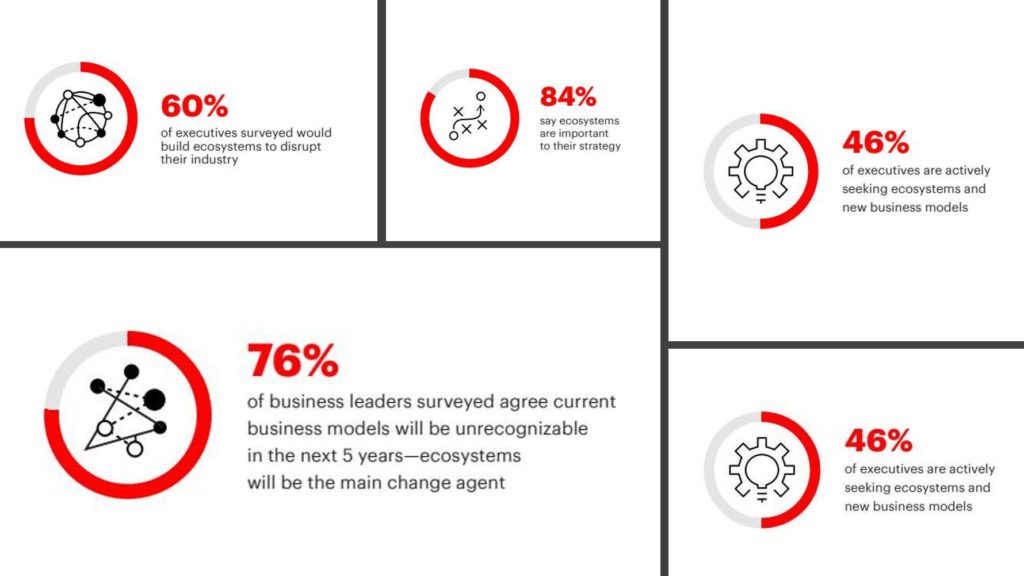An ecosystem consists of organisations and the environment in which they interact. This is how I'd apply the definition of an ecosystem in the context of economies – no matter the size. One characteristic of an ecosystem, as defined by the National Geographic Society, is the connectedness of the elements inside an ecosystem. At some point, the interdependence is so deep that taking one critical element out impacts the rest – at least until a replacement is found.
The idea of an ecosystem is that "we can't go it alone!" says Jay McBain, chief analyst at Canalys. Back in 2018, Accenture's Disruptability Index found that 40% of companies across 20 industries, representing US$26 trillion in combined value, are highly susceptible to future disruption. CEOs participating in the survey point to ecosystems as the number one reason why they think "their current business model will be unrecognisable in five years."
Executives in the Accenture survey believed that ecosystem participation allows businesses to innovate (63%), increase revenue growth (58%), access new markets (55%) and access new customers (55%).

Technology companies are a good example of businesses that thrive best in an ecosystem. Some of the best-known brands are built around partnerships of different companies, big and small, agreeing to cooperate toward common interests.
FutureCIO spoke to Kate Wooley, general manager for IBM Ecosystem at IBM, to talk about partnerships in ecosystems.
According to McKinsey, 6 of the top 7 companies in the world are ecosystem companies that have used hyperscale platforms to compete in the market. Do you agree that, in the current environment, this ecosystem approach offers an attractive proposition to businesses and consumers?

Kate Wooley: Client expectations are always evolving. Today’s clients demand more specialised solutions and services, and they want to receive them faster, more efficiently, and in a personalised way. Those needs can’t be fulfilled by one vendor alone, and a strong ecosystem is a critical tool to leverage partnerships to deliver on this complexity.
Let’s take our own example. The IBM Ecosystem is a multibillion-dollar entity, comprising tens of thousands of partners across many different platforms including hyperscalers. IBM acts as a convener of strategic partners of all kinds, including traditional business partners, technology, and infrastructure players, as well as solution and service providers large and small.
Our ecosystem approach is to meet our clients where they are, creating opportunities for companies of all types and sizes to grow with us and together help solve the industry’s most complex challenges.
Define for us what partnering means in the context of this ecosystem economy?
Kate Wooley: The partner ecosystem has become one of the most powerful forces in technology, and a growth engine for businesses. A strong ecosystem allows you to grow the pie for everyone and meet our clients where they are at, to provide the solutions they need.
Why is partnering so important in the digital economy?
Kate Wooley: Here’s a great example based on a collaboration between TIME dotCom, a Malaysian company providing telecommunications services, and Persistent Systems, based in India and providing technology services to its clients.
The COVID-19 pandemic intensified the pressure on communications service providers (CSPs) to address the exponential increase in people working from home. For TIME dotCom that meant delivering a solution for their customers that would help them advance their digital transformations and adoption of cloud to meet these new challenges.
TIME dotCom needed to maximise its speed and consistency and enable agile access to an ever-growing ecosystem of services. It wanted to give customers more network flexibility and provide the best customer experience from the moment of onboarding. To find the right orchestration solution, TIME dotCom invited proofs of concept from multiple companies. One of them was IBM Ecosystem partner, Persistent Systems.
The Persistent team pitched a solution based on IBM Cloud Pak for Network Automation. TIME dotCom chose to move forward with the Persistent and the IBM solution, becoming one of the CSP industry's early adopters of network automation technology. They can now deploy services with approximately 80% less effort and require approximately 20 times less manual activity to maintain operations at scale.
The world today requires the most advanced digital solutions of our time.
What qualities make for a win-win in this ecosystem economy? Why would companies want to be part of this ecosystem?
Kate Wooley: I’ve spoken about how today’s IBM Ecosystem is centred in part around a shared vision for the future of hybrid cloud and AI, and how our partners benefit from working together around that market opportunity.
Now let’s look inward. The new IBM Ecosystem approach represents the biggest change to our go-to-market model in 30 years, simplifying the way our partners work with us, access clients, and deliver consistent client experiences.
We know our partners want a super-simplified, streamlined way of doing business. And we’re delivering on that and giving them more resources – for example, by doubling our brand specialised capacity and increasing technical specialists by 35% to support them.
But we’re also helping them with their ground game, through a brand campaign called Let’s Create that helps create a pull in the market, through demand generation and co-marketing activities that let them sell more and sell faster.
It’s a new, more inclusive way of doing business, and there’s more to come.
We often hear the word “partnership” or “partnering” to describe what enterprises are looking for in their vendor suppliers. How does this apply in the ecosystem economy?
Kate Wooley: I would say that evolving client expectations dictate how businesses and partners work together to create solutions. Today, clients want specialised solutions and services – delivered faster, more efficiently, and more tailored to their preferences for how to do business.
Given the evolving nature of economies, including geopolitical tensions (may not need to comment on this geopolitical issue but merely including it here to put more context), how do you sustain a community of different, sometimes competing, companies in an ecosystem?
Kate Wooley: It’s no secret there are companies we work with that may also compete with us in certain areas. My view is that each of us has more to offer each other than not, and if we focus on those areas of mutual understanding that develop in-demand solutions for our clients, then we grow the pie and our businesses at the same time.
What is your advice to businesses (end-users) when evaluating solutions from technology vendors (as it pertains to ecosystems and partnerships)?
Kate Wooley: I believe that businesses today are asking for vendors to provide unparalleled choice and the flexibility, speed, and agility to operate workloads and applications on-prem or in any cloud environment. That is the beauty of a hybrid cloud.
My advice is to look for a company that can help provide the best solutions for your needs, either directly or through the ecosystem of partners they offer
How should CIOs evaluate this ecosystem when developing their IT roadmap?
Kate Wooley: We recently surveyed 2,500 CIOs and found while CIOs continue to deliver the core IT services that power day-to-day business operations, they are also often expected to help drive innovation and business growth.
There is a growing role for partnership in this equation. Since CIOs are largely responsible for managing digital transformation implementations for their companies and want tailored solutions that no one company alone can provide, they should look for an ecosystem of partners that can provide end-to-end support for their needs. For example, if a CIO wants to manage workloads in AWS or Azure but wants the flexibility of being able to move them across environments, IBM offers that capability with Red Hat OpenShift and the services of IBM Consulting.
The bottom line is that everyone wins by combining joint strengths.





